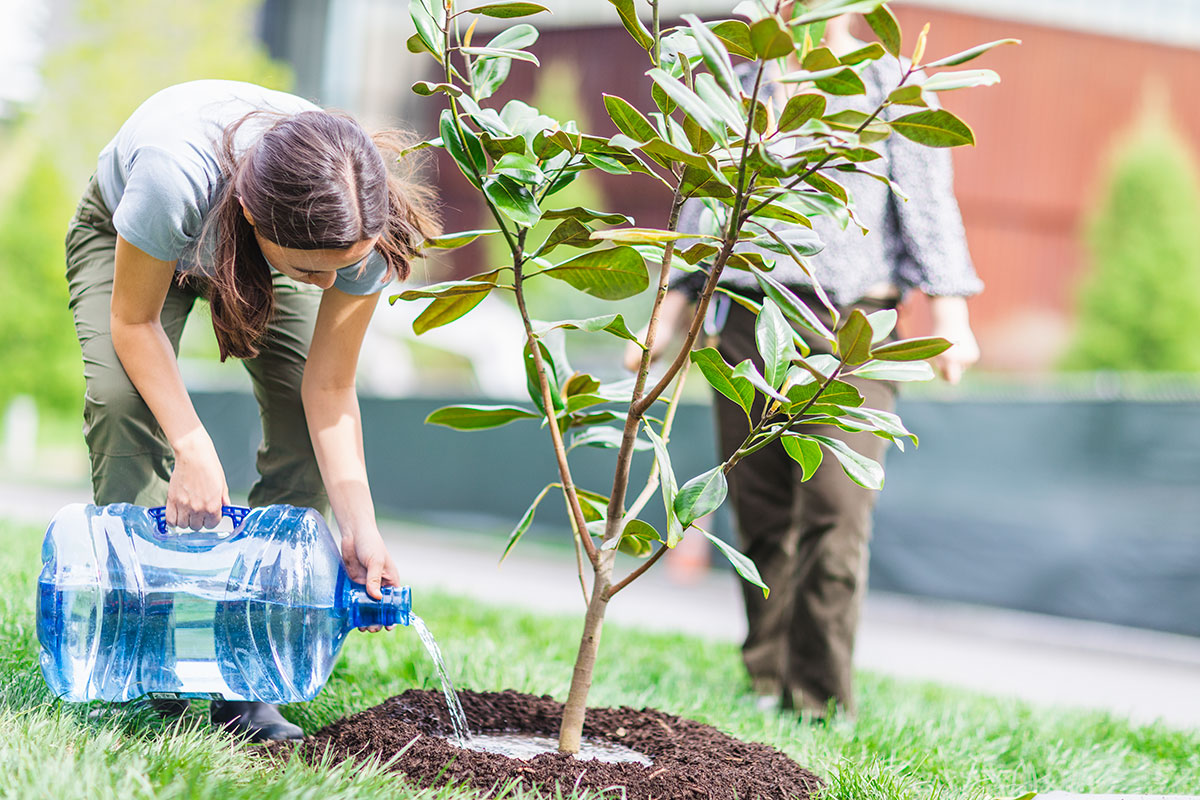
A “Black Dragon” Japanese cedar being planted by Frost Library
“Let’s plant some trees and things!” said Kenny Lauzier, Amherst’s supervisor of landscape and grounds.
Lauzier was addressing a small crowd on the sunny afternoon of Friday, April 28—Arbor Day—and the event’s mission was two-fold: to plant four young trees and to mark the College’s new status as a Tree Campus, officially recognized by the Arbor Day Foundation for its commitment to nurturing trees and to educating community members about them.
The crowd assembled outside of Barrett Hall, and included the tree-planting crew of Karl Longto and Rachael Peters, both gardeners in the Buildings and Grounds division; Wes Dripps ’92, director of sustainability; Willoughby Carlo, then Green Dean in the Office of Sustainability; and several Student Sustainability Fellows.

A sycamore tree planted by Barrett Hall
Dripps arrived at Amherst in 2021 having already helped his previous workplace, South Carolina’s Furman University, achieve Tree Campus certification. Last summer, as an outreach and engagement fellow with the Office of Sustainability, Joseph Jerome Raymond ’24 helped Amherst apply for the program.
The College is now one of 410 Tree Campuses nationwide and only seven in Massachusetts.
On Arbor Day, which Tree Campuses are expected to celebrate every year, Lauzier and Dripps led the group to four different planting sites. Along the way, they talked about a few of the notable specimens that have long stood on Amherst College property, such as the rare stand of self-propagated Chinese chestnuts located near Book & Plow Farm in the Wildlife Sanctuary and a white oak at the Emily Dickinson Museum that the poet’s family planted more than 160 years ago.

Megan Goh ’24 (left) Emily Byers ’25 watering the sycamore tree by Barrett Hall
The gardeners and students positioned each sapling in the soil according to Lauzier’s advice about how deep it should go: “Plant it high, it’ll never die. / Plant it low, it’ll never grow.” Then they shoveled on some dirt, surrounded the base of each sapling with mulch made from the fallen leaves of other campus trees, and watered everything thoroughly.
The four new trees are a sycamore between Barrett Hall and Chapin Hall; two “Black Dragon” Japanese cedars—one between Barrett and Frost Library and the other near the Service Center; and a Southern magnolia next to the Beneski Museum of Natural History.
One could say that, even before it was planted on campus, the magnolia had Amherst roots: Though the College bought the tree from Sugarloaf Gardens in Sunderland, Mass., it was originally cultivated at Summer Hill Nursery in Madison, Conn.—a business run by Mike Johnson ’53. (Another of the nursery’s hardy Southern magnolias is at Smith College, which is also a designated Tree Campus.)

Anna Hogarth ’23 waters the southern magnolia planted by the Beneski Museum.
“I doubt if there are many Amherst graduates that are in the nursery trade,” Johnson muses. He earned a B.A. in biology and history at Amherst, spent two years in the Army and worked at a plastic factory before realizing “that I could not work inside. I just wanted to be outside,” he says. “So I took a job at a local nursery.” He went on to study at the UMass Stockbridge School of Agriculture. After he founded Summer Hill in 1957, it became one of the first nurseries in New England to grow landscaping plants in containers.
Johnson marvels that it has been 70 years since he was a student on Amherst’s campus. And it’s possible that the Southern magnolia and the other trees planted this spring will still be growing there 70 years after today’s students graduate.
As Dripps told the Student Sustainability Fellows just before their shovels went into the earth: “This is our legacy moment.”
